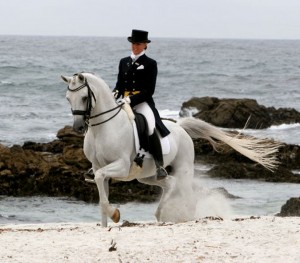The Beauty of Dressage
For a person who loves horses, the word ‘Dressage’ evokes powerful, harmonious and beautiful images. The perfect partnership between horse and rider.
Today for Thursday Art-Day we celebrate the Dressage horse with two wonderful artworks by Willa Frayser.
A black and white print from a graphite drawing titled ‘Extension – Grand Prix Dressage’
and
an original oil on canvas ‘Half Pass’ (signed prints available) www.willafrayserstudio.com
Also included for the first time on Art-Day is a truly lovely photograph, by Romney Maupin of OKW Entrigue ‘Ricky’ on Pebble Beach.
When I saw this photograph I knew I just had to include the image with Willa’s fantastic artwork. OKW Entrigue is a Purebred Arabian stallion of pure Polish bloodlines. He is also a six times National Champion and owned by www.glynnsongfarms.com
Below is an article written by Anita Lamb for www.ezinearticles.com
History of Dressage
By Anita Lamb www.ezinearticles.com
The word “dressage” is French, and is most commonly translated as “training.” On her website, Theresa Sandin defines dressage as: “The guiding of a horse through a series of complex manoeuvres by slight movements of the rider’s hands, legs, and weight.” The rider is not simply a passenger, but an active member of a horse-human duo.
It has been said that dressage is both a journey and a destination, with the core purpose of developing, “through standardized progressive training methods, a horse’s natural athletic ability and willingness to perform, thereby maximizing its potential as a riding horse.” In short, after a lifetime of studying dressage, a horse and rider make the strenuous look effortless.
Dressage has its roots classical Greek horsemanship, evolving out of the necessity to train horses to fight in battle, and those training techniques, over time, have been employed to create an elegant dance in the show ring. It came to be considered an “important equestrian pursuit” during the Renaissance. By 1912, dressage had become an accepted form of training and riding, although it took many more years before men who were not in the military and women came into the picture as serious dressage riders and competitors.
The dressage arena is a rectangle, with letters placed at evenly spaced intervals around the perimeter. Competitors use the arena to present dressage routines, called “tests.” The letters are markers that dictate how and where particular moves are executed. Lower level tests are performed in a smaller arena, usually at a walk or trot. The movements are simpler and focus on lower level goals, like how well the horse bends around the rider’s leg (flexibility) whether the rider is on the correct diagonal while posting at a trot. Higher level tests are performed in a larger arena, and will include all gaits (walk, trot, canter, gallop), as well as more complicated movements, like flying lead changes or pirouettes.
Currently, competitive dressage has nine levels, with progressively more difficult tests in each level. There are also tests written for musical freestyle, sport horses, and for multiple horse and rider pairs. However, in all levels of dressage competition, judges will consider rhythm, regularity, relaxation, contact, impulsion, and collection.
While there are many horses that are capable of performing dressage manoeuvres (Quarter horses, Arabs, Thoroughbreds, Warmbloods, and even some draft horses have all made it to the highest levels of dressage competition), you need the horse that is right for you. This is the trickiest part – the part that is the “art,” and emotion, because there is only so much science and breeding will tell you. Only you and your dedication to the relationship will determine if you and your horse will forge the deep bond necessary to go all the way. And finally, if you want to train all the way to the top, you must start with horse that is fairly young, say three or four years old. It takes years to train a horse properly (most Grand Prix and Olympic horses are in their teens).
From the perspective of the spectator at a dressage competition, the rider should not appear to be overtly directing the horse in any specific way. It should look as though the horse and rider have become one being, and are moving together in complete unity. Watching a high-level (Grand Prix or Olympic) should be like watching a ballet on horseback.
Article Source: http://EzineArticles.com/1640509



2 Responses
Polly J. Knoll
Excellent descriptions about dressage! I watched Captain St. Cyr (spelling?) demonstrate the ride on his winning horse in Madison Square Gardens many, many moons ago (perhaps 50 years).. The rider had his horse change leads perfectly every step as he rode diagonally across the arena while the announcer spoke, “It looks like a happy little boy skipping home.” Unforgettable. This was also the same program that featured many amazing jumping horses including Nautilus, the horse with the flying tail who inspired the movie.
Carmel Rowley
Hello Polly a lovely post thank you. I remember Nautilus with the flying tail. He was featured in one of my horse books as a young girl. And yes, I loved the movie.
Kindest regards Carmel